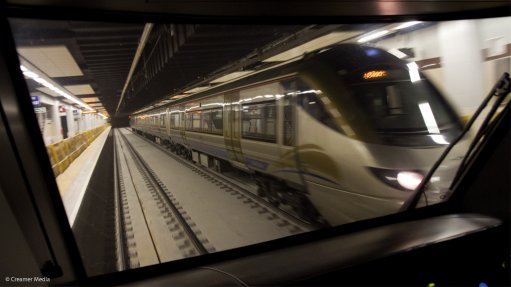
Photo by: Duane Daws
While the inflow of water into the Gautrain tunnel, specifically in the section between Johannesburg Park Station and Emergency Shaft 2 (E2) did not endanger the Gautrain operating system in the short term, government was concerned about the longer-term impacts this could have on the environment, as well as the operating system, Gautrain Management Agency (GMA) CEO Jack van der Merwe said on Thursday.
Speaking at a media briefing following an award by the arbitration tribunal in the tunnel water ingress dispute between the Gauteng provincial government and the Bombela Concession Company on Wednesday, through which it ordered Bombela to undertake immediate remedial work on the tunnel section between Park Station and E2, Van der Merwe pointed out that government had a much longer-term outlook with regard to the rail line than that of Bombela.
“Rail tunnels last for 100 years; however, the concession period is only 15 years. Therefore, the concessionaire has a much shorter timeframe in mind when they look at the tunnel, while we, as government, will stay the owner of the project for the next 100 years and, therefore, we are saying that this [inflow of water] is unacceptable,” he told Engineering News Online.
When asked by when the GMA would like the water inflow problem rectified, Van der Merwe responded that government would have preferred if this had been dealt with from the start.
“What we are going to do now is go into a construction phase, while we are actually operating. While we [had] planned to have distinct construction and operational phases, we will now have two systems running at once,” he said.
Also speaking during the media briefing, Gauteng Roads and Transport MEC Dr Ismail Vadi explained that local and overall specifications were set out for the inflow of water into the Gautrain tunnel.
According to the overall tunnel specifications, the water flowing in had to be limited to 1 ℓ per 1 m2 a day, while local specifications for the specific section of the tunnel required a water inflow limit of 10 ℓ for every 10 m of tunnel every minute.
“Currently, the Park Station–E2 section does not meet either of these requirements,” Vadi said.
Meanwhile, Murray & Roberts (M&R), which had a 45% stake in Bombela Civils Joint Venture, on Wednesday, during a media conference call, said there was no “obvious technical solution” to the water ingress problem.
“Therefore, our experts will now liaise with government experts to determine the best course of action,” M&R group CEO Henry Laas said.
He noted that the solution would most probably make use of grouting, as had been done before; however, the design and specifications still required a lot of work.
“Because the solution is not obvious, it would probably not be agreed upon by all parties in the near future and would only be implemented some time next year,” he added.
Meanwhile, Laas also stated that Bombela would attempt to reduce the impact of this necessary work on the train and its users, adding that the consortium was considering using the so-called “maintenance hours” to do the work.
“However, if this is done, the work will take longer, as only about three out of every 24 hours will then be used to work,” he pointed out.